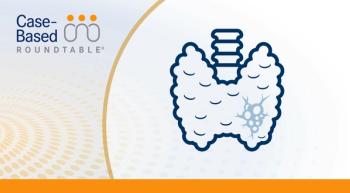
Larotrectinib and The Risk of Fracture in TRK Fusion Thyroid Cancer
Theodore W. Laetsch, MD, an attending physician with the Cancer Center at Children’s hospital of Philadelphia discusses if there is an increased risk of fractures with larotrectinib in patients with TRK fusion positive thyroid cancer.
Larotrectinib (Vitrakvi), a TRK inhibitor, has demonstrated efficacy in both adults and children with TRK-fusion cancers. However, questions around an increase in fractures associated with the agent remain.
Of patients treated with larotrectinib, between 75% and 80% have an objective response, with many of those responses being durable. The agent has also proved to be both age and histology agnostic and has shown activity across a number of tumor types, including in thyroid cancer.
In order to determine if larotrectinib increased the risk of fractures, investigators looked at data from 3 trials, the adult phase 1 trial (NCT02122913) of larotrectinib with general patients, with or without the presence of a TRK fusion, the pediatric SCOUT study (NCT02637687), and the adult and adolescent phase 2 NAVIGATE (NCT02576431) trial.
Theodore W. Laetsch, MD, an attending physician with the Cancer Center at Children’s hospital of Philadelphia discusses if there is an increased risk of fractures with larotrectinib in patients with TRK fusion positive thyroid cancer.
TARGETED ONCOLOGY: What efficacy has been shown with larotrectinib and what impact has it had since it's been FDA approved?
LAETSCHT: We continue to update the data on the efficacy of larotrectinib. But it's been very consistent, that between 75% and 80% of patients treated with larotrectinib who have TRK fusion cancers have objective responses. And those responses are quite durable. In pediatric patients, I'm a pediatric oncologist, the median duration of response still hasn't been reached. The majority of patients are still ongoing on therapy. So, I think the really exciting nature of larotrectinib efficacy that we've seen is that it's both age agnostic, so there was children and adults included in the trials from very early on, and also histology agnostic, meaning that we see an activity across a very large number of different tumor types with TRK gene fusions in a very profound and durable way. What is the general adverse event profile with this drug and solid tumors? So larotrectinib is a TRK inhibitor. And so, some of the adverse events that we see are part of this class of agents and related to TRK inhibition, and those include some neurologic adverse events like fatigue and dizziness. We also will occasionally see patients when we discontinue this therapy, will have some pain at the time of withdrawal that can last for several days, again, but to be due to inhibition of the TRK receptor. On some patients will also see have dizziness. We see some potentially off target effects, meaning not clearly related to inhibition of the TRK receptor. In children. The most common of these are mild elevations in liver function tests and mild cytopenias, neutropenia most commonly.
Can you give some background on your analysis of fractures? How did this come about?
There's been concern about an increased rate of fractures in patients treated with other less specific TRK inhibitors specifically entrectinib. And so, we decided to look through the larotrectinib data from patients treated on any of the clinical trials that are ongoing and led to FDA approval of larotrectinib to evaluate the rate of fractures to see whether that was common or not in this group of patients.
What trials are these data pulled from? And what can you tell me about the patient population that you've assessed?
It's pulled from 3 different trials. So, the adult phase 1 trial of larotrectinib with general patients, with or without the presence of a TRK fusion, and then the pediatric SCOUT study which enrolled patients, again initially with or without the presence of a TRK fusion, but was subsequently amended to only enroll patients with TRK fusions for the phase two portion. And then the adult and adolescent phase 2 trial called NAVIGATE. Both of those latter trials are still ongoing with patients. And so, this has included a group of patients that ranged from very young, less than a month of age until elderly adults, and with a wide variety of different histologies. Looking at the safety outcome, it didn't restrict the analysis to patients with TRK fusions and included patients with or without TRK fusions, all patients who enrolled on those trials.
What results have you seen so far?
We evaluated the rate of fractures in patients treated on those 3 clinical trials and found that the rate of fractures was really quite low, approximately 7% for the entire cohort of patients, which is in keeping with the expectations for patients with advanced cancer enrolled on such trials, and not clearly showing any evidence that the rate of fractures is increased with larotrectinib treatment.
I think it' important to highlight that we are continuing to gather additional safety data, that these trials are ongoing. And especially in children that are growing, it's important to continue to gather this data, but certainly we were happy to see these results.










































